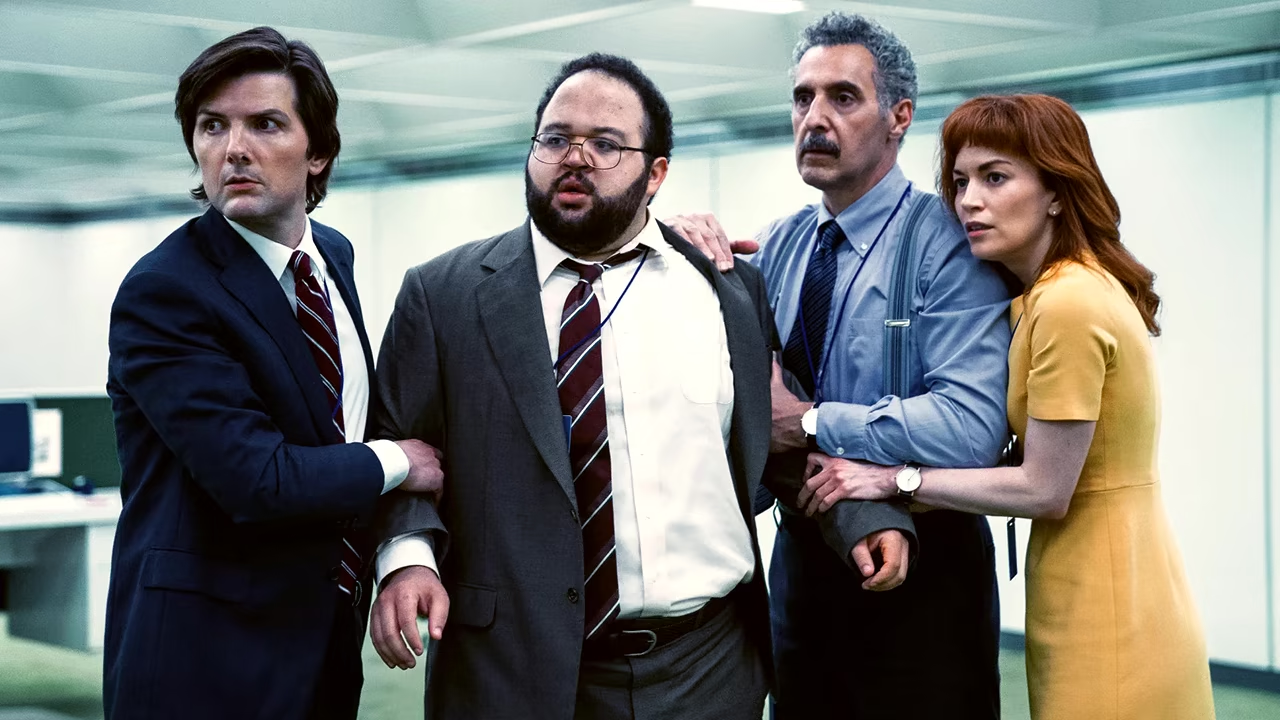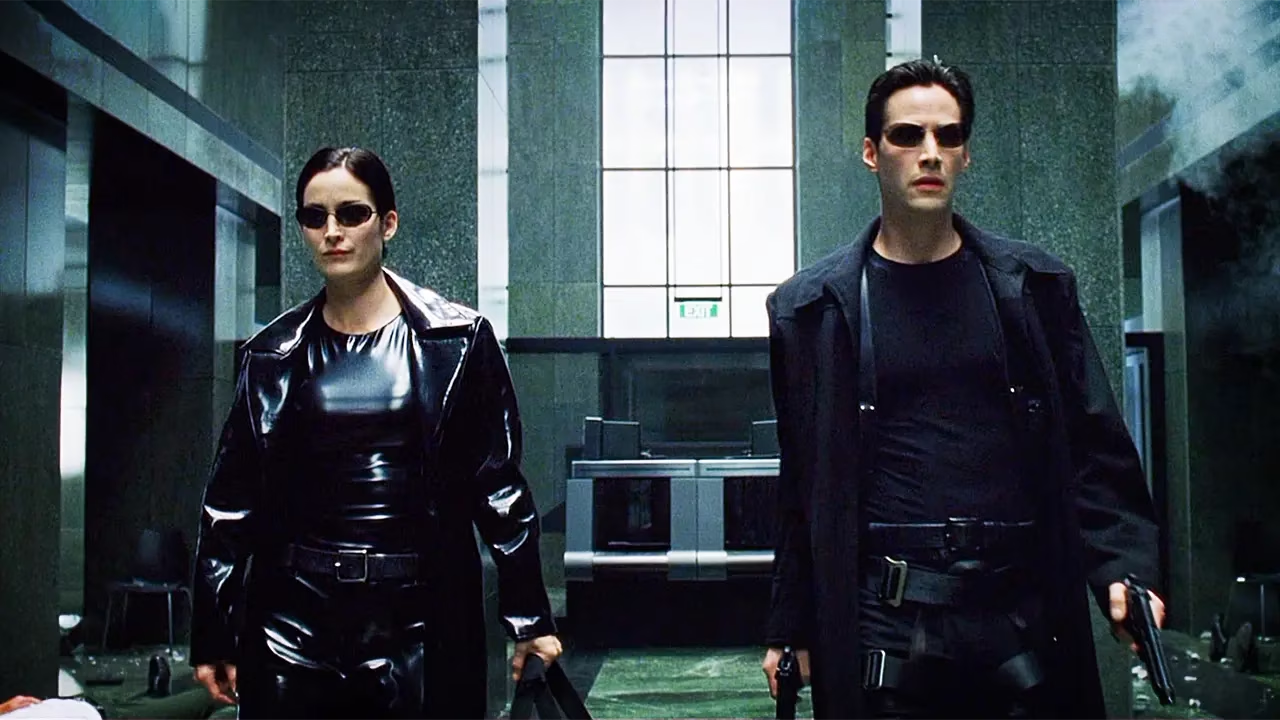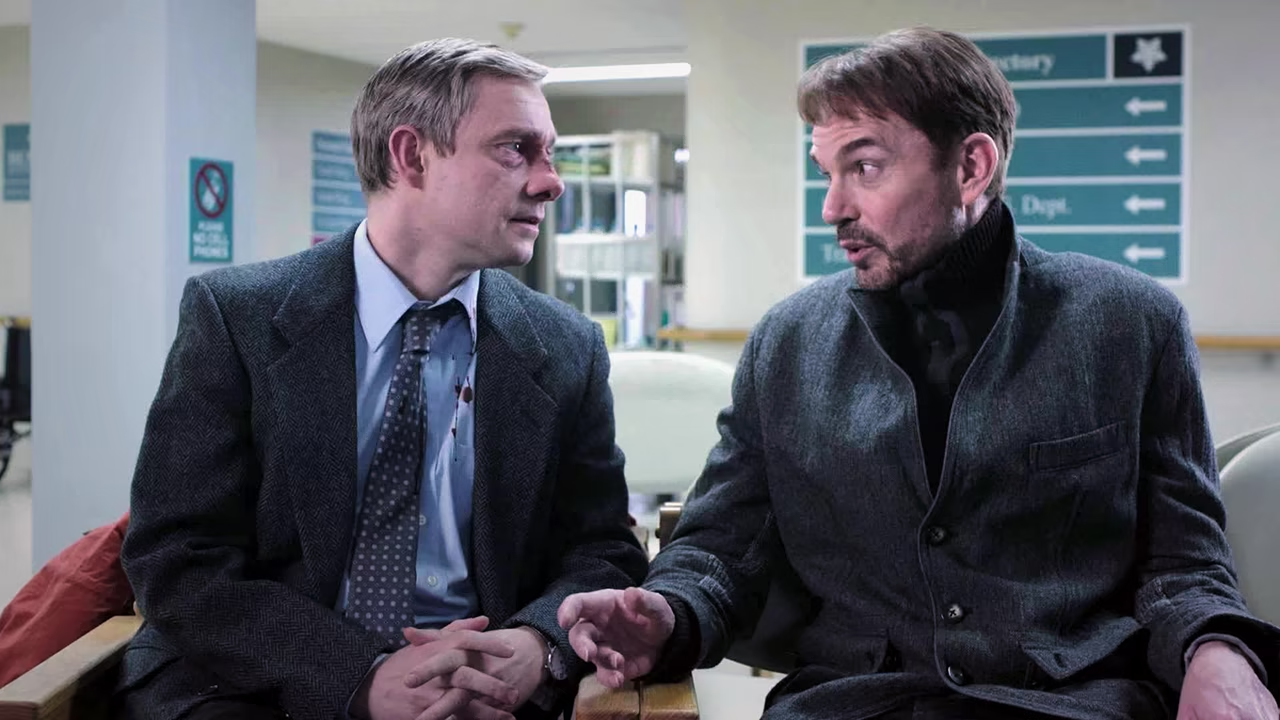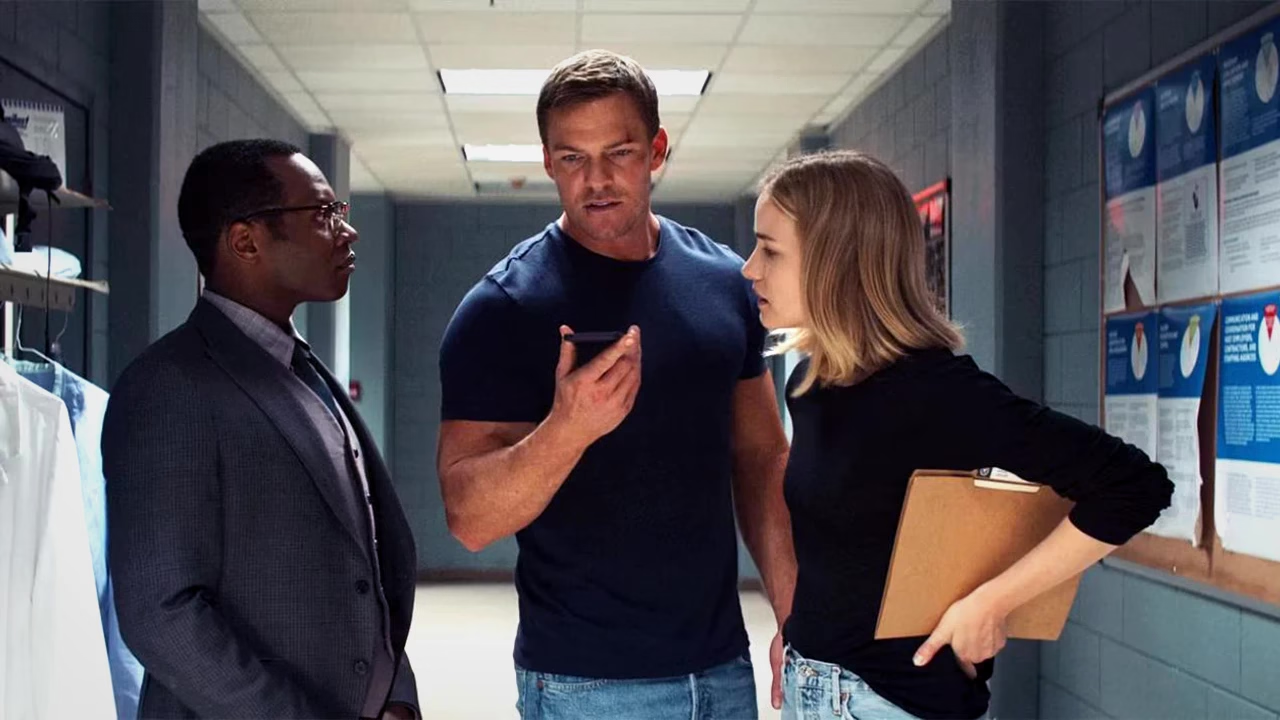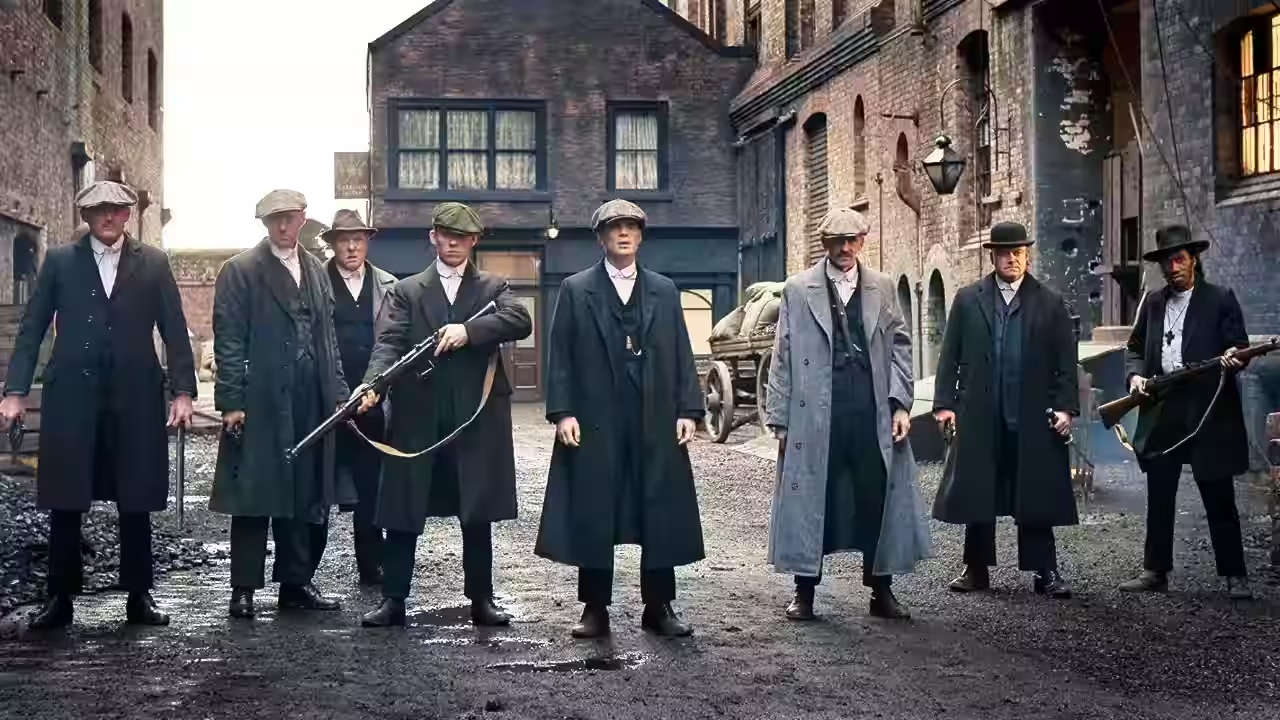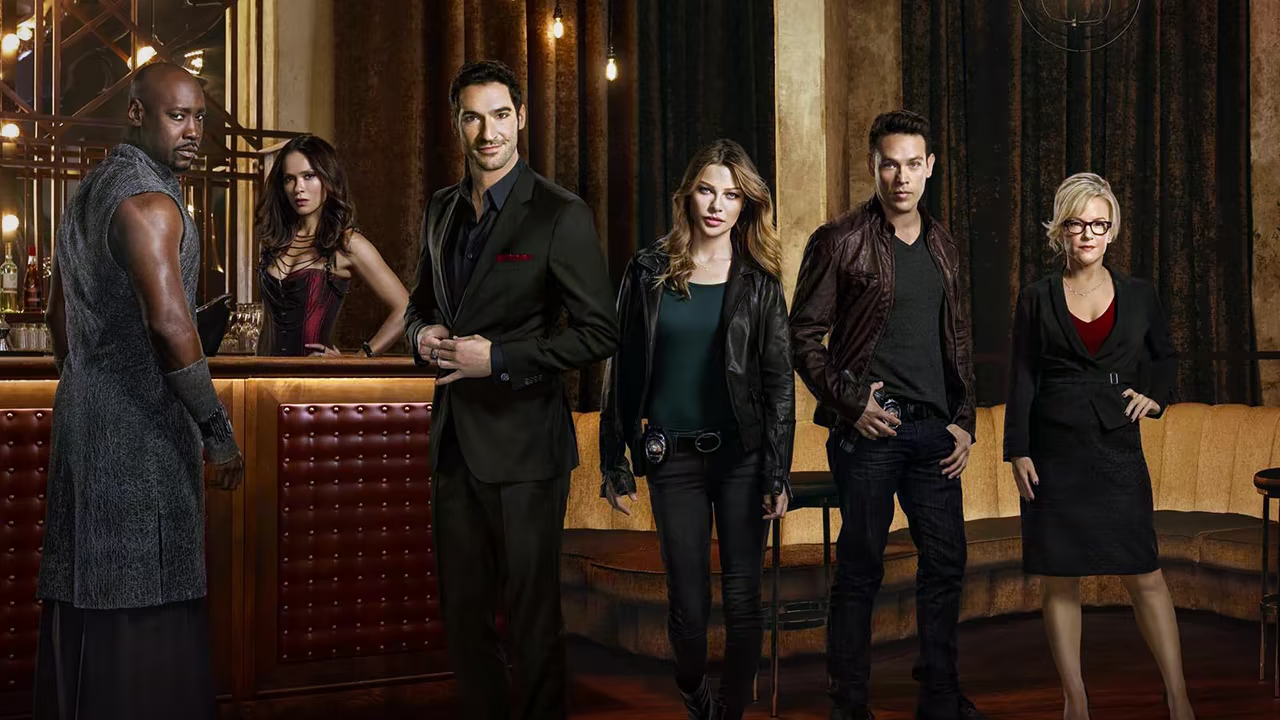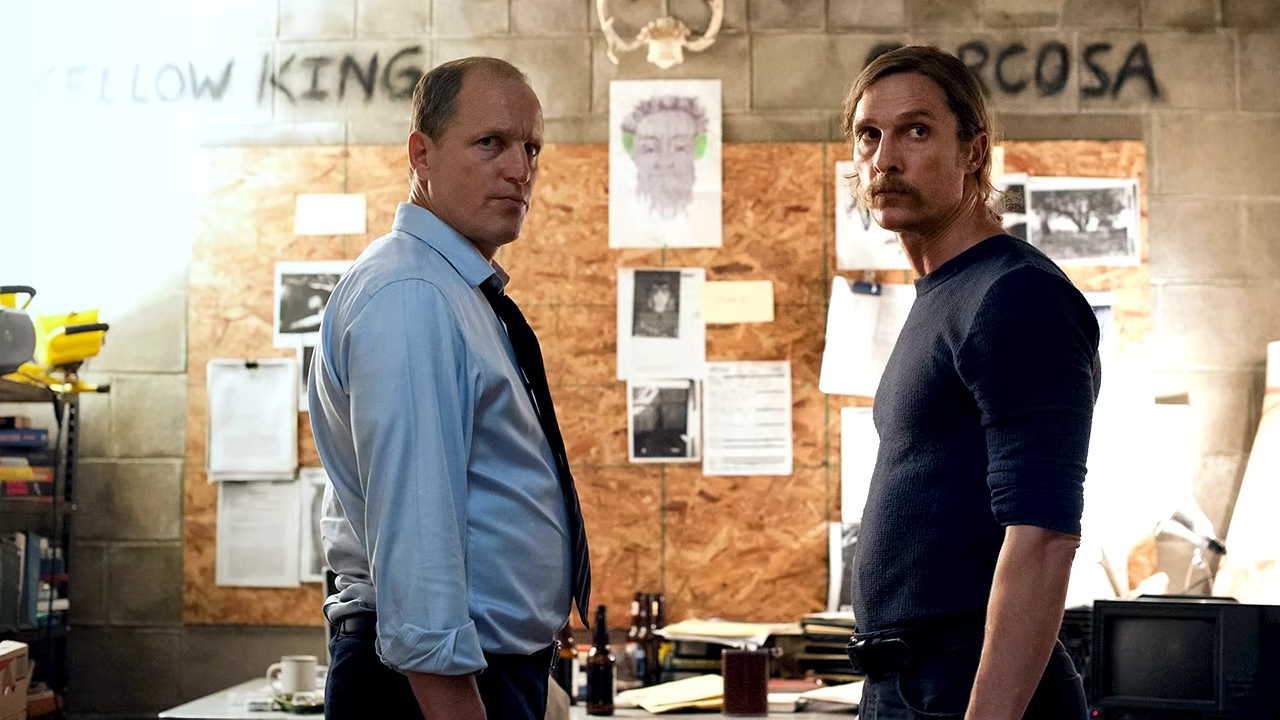
True Detective is an anthology series that transcends the boundaries of conventional crime drama, with its first season offering a profound exploration of existential despair, cosmic horror, and the duality of human nature. Set against the haunting backdrop of rural Louisiana, the series follows detectives Rust Cohle (Matthew McConaughey) and Marty Hart (Woody Harrelson) as they delve into a series of ritualistic murders linked to a clandestine cult. The narrative intricately weaves themes of nihilism, anti-natalism, and the illusion of time, which is epitomized by Rust’s assertion that “time is a flat circle”, and draws inspiration from philosophical figures like Nietzsche and Schopenhauer. This philosophical depth elevates the series beyond a mere whodunit and positions it as a meditation on the human condition and the pervasive darkness within.
The show’s atmospheric storytelling is deepened by its Southern Gothic elements and Lovecraftian horror, notably through references to “The Yellow King” and “Carcosa”. These elements infuse the narrative with an unsettling, otherworldly dread. Director Cary Joji Fukunaga’s cinematic vision, which features long takes and a muted color palette, draws viewers into a world steeped in decay and corruption. The dual timelines not only unravel the central mystery but also reveal the psychological transformation of the protagonists. This narrative structure culminates in a finale that contrasts the abyss of despair with a faint glimmer of hope. True Detective season 1 stands as a landmark in television storytelling because it blends genre conventions with philosophical inquiry in a way that is both intellectually provocative and emotionally gripping.
Initial Murder Investigation
In 2012, two former Louisiana State Police detectives, Martin “Marty” Hart and Rustin “Rust” Cohle, sit for videotaped statements. In separate, sterile rooms, investigators ask them to revisit a case from seventeen years ago that made them local legends before shattering their partnership. Marty, now a private investigator with a softer, settled demeanor, recounts the events with a storyteller’s weariness. Rust, looking ravaged by time, his face a roadmap of hard living, is cynical and contemptuous. His dialogue is steeped in philosophical pessimism and anti-natalism, reflecting his beliefs that life is overwhelmingly full of suffering and that procreation is morally wrong. He describes time as a “flat circle”, an allusion to eternal recurrence and the endless reliving of a painful existence.
The story returns to 1995, where a call brings Marty and Rust, who had been partners for three months at that point, to a sugarcane field and the body of a woman. The scene is grotesque, with the victim naked and posed kneeling at the base of a large tree, as if in prayer. A crown of deer antlers rests on her head, and a spiral symbol is painted on her back. Above her, a strange latticework sculpture made of twigs hangs from a branch. Based on her scraped knees and poor dental hygiene, the victim is quickly identified as a local prostitute. Rust, an unnervingly intense and perceptive detective, quickly deduces that the killer is a repeat offender. He coins the term “meta-psychotic” to describe a perpetrator who builds an elaborate symbolic framework around their crimes—essentially turning their madness into a self-referential mythology.
Marty, more conventional and grounded, resists this theory, preferring a simpler explanation. From the outset, the contrast between their investigative styles is evident. Rust’s unconventional approach and philosophical musings make him an outcast within the department. He is a loner, his mind always churning, meticulously documenting his thoughts and observations in a large ledger. In an attempt to bridge their personal divide, Marty invites his brooding partner to dinner. That night, Marty briefs the local mayor on the murder and describes Rust as brilliant, though difficult to work with. While Marty manages the bureaucratic side of the investigation, Rust dives into the darker corners of their jurisdiction. He visits a truck stop brothel to question prostitutes about the victim but finds no useful leads.

As Rust delves deeper into the investigation, the victim is identified as Dora Kelly Lange. The autopsy reveals methamphetamine and LSD in her system, along with clear signs of torture. She was drugged, bound, and tormented before being ritually posed at the scene. While canvassing a nearby neighborhood, a resident mentions a missing girl named Marie Fontenot, who vanished years earlier. The sheriff says the case was dismissed because her mother was a drug addict and authorities assumed the father took her, an explanation that deeply unsettles Rust. The detectives also hear of a child who claimed to be chased by a “spaghetti monster with green ears”, a report local police dismissed as a drug-fueled hallucination. At a derelict church, they question a pastor who recognizes the twig sculptures as “devil nets”, a term from his Santeria-practicing aunt, intended to ward off evil spirits.
Cult Connections Emerge
Their investigation leads them to Dora’s incarcerated ex-husband, Charlie Lange (Brad Carter). He speaks of a disturbing phone call from Dora where she rambled about becoming a nun and meeting a powerful man she called “the king”. Later, Rust attends dinner at Marty’s house, an uncomfortable evening. Rust, having had too much to drink, is uncomfortably candid. He reveals his tragic past, explaining he transferred from Texas narcotics after his young daughter’s accidental death. This event shattered his marriage and left him emotionally hollow, reinforcing his anti-natalist belief that humanity should stop reproducing. The conversation leaves Marty’s wife, Maggie (Michelle Monaghan), both pitying and fascinated by the peculiar detective.
They discover another devil’s nest in the chicken coop of an abandoned property once belonging to Marie Fontenot’s uncle. This finding strengthens Rust’s conviction that Dora’s murder is connected to Marie’s disappearance. They begin to uncover more details about Dora’s final weeks. She had started attending church again and had moved into a shelter in the southern part of the state. As the case stalls, tensions between the partners grow. Meanwhile, Marty’s personal life contradicts his professed family values. He has an affair with a court reporter, Lisa Tragnetti (Alexandra Daddario). One day, Rust detects a different perfume on Marty, confirming his suspicions of infidelity and adding another layer of distrust to their relationship.
Marty and Rust follow a lead south to a remote trailer park known as “The Ranch”, a brothel employing underage prostitutes. There, they meet Beth (Lili Simmons), a teenage girl who was close to Dora Lange. Beth provides them with Dora’s belongings, including a diary filled with unsettling references to “The Yellow King” and a pamphlet for a church. Disturbed by Beth’s young age and circumstances, Marty confronts the brothel’s madam, Jan (Andrea Frankle), about employing underage girls. Before leaving, he gives Beth money and encourages her to seek a different path in life. Later, Rust and Marty visit the church mentioned in Dora’s pamphlet, only to find it has burned down years prior. Inside the ruins, they discover a disturbing painting on a charred wall, depicting a woman in a pose eerily similar to Dora Lange’s.
Their investigation then takes them to a revival tent meeting led by the charismatic preacher Joel Theriot (Shea Whigham). Rust, a staunch anti-theist, views the fervent worship with disdain. Theriot recalls seeing Dora at a few services, often with a tall, heavyset man with prominent scars on his face. While Rust methodically continues the investigation, Marty’s personal life unravels. After seeing Lisa with another man, he breaks into her new boyfriend’s apartment in a drunken rage and assaults him. The next day, Rust reveals a breakthrough in the case. A body pulled from the bayou bears the same spiral marking as Dora. The victim’s grandfather mentions that his grandson had known a man named Reggie Ledoux (Charles Halford) and had once attended a Christian school run by the Wellsprings Initiative, a network of religious schools established in rural areas.
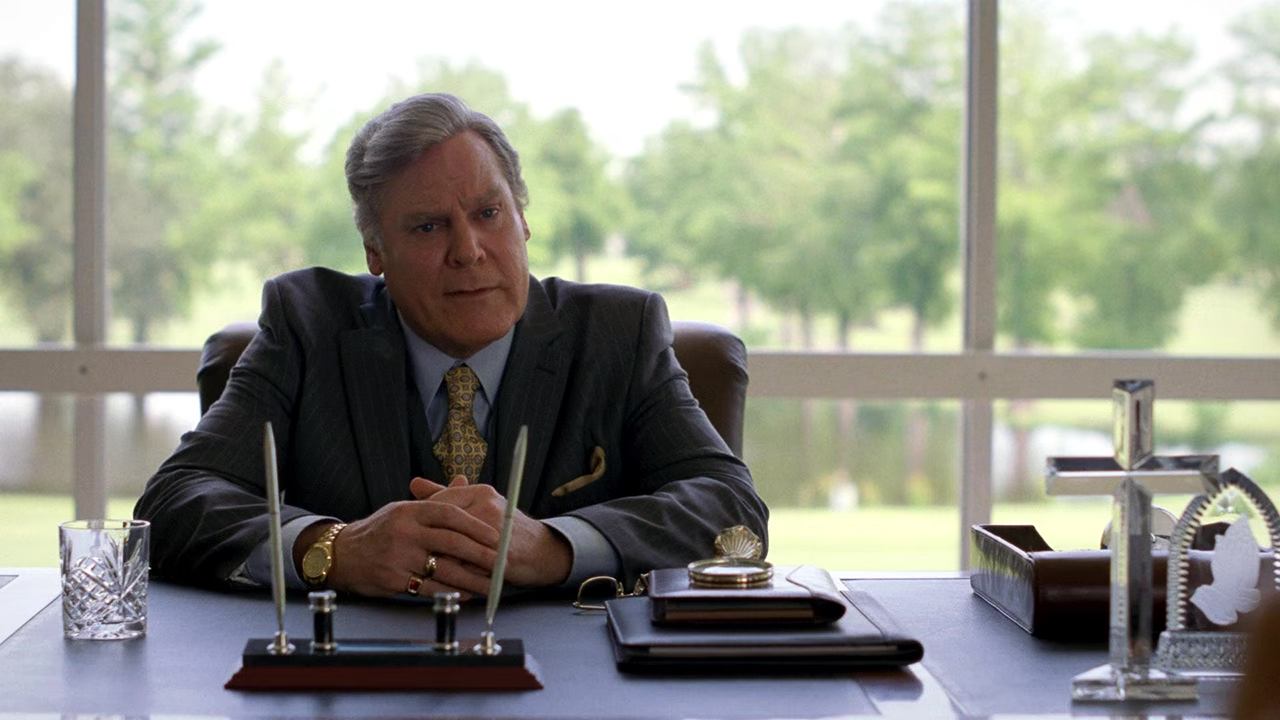
Explore More:
They soon learn that the powerful Tuttle family, a political and financial dynasty with deep influence across Louisiana, funded the Wellspring Initiative. While visiting the now-defunct school associated with the program, Rust speaks briefly with a groundskeeper. Before they can delve deeper into the school’s history, a lead surfaces on Reggie Ledoux, whose criminal record includes convictions for producing meth and LSD, which are the same drugs found in Dora’s system. They re-interview Charlie Lange, Reggie’s former cellmate, who describes Ledoux as a terrifying figure obsessed with occult ideas. Charlie recounts that Ledoux often spoke about “Carcosa”, a mysterious place where wealthy men allegedly engage in devil worship and human sacrifice, leaving victims marked with a spiral symbol that matches the brand Ledoux had on his back. During the conversation, Charlie also mentions Tyrone Weems (Todd Giebenhain), a known associate of Ledoux.
Meanwhile, Marty’s personal life unravels. After Lisa reports his assault, Maggie discovers the affair and throws him out of the house. Distraught and seeking a distraction, Marty throws himself into the case with renewed determination. Acting on Charlie’s lead, he tracks down Weems, who reveals Ledoux produces meth for the Iron Crusaders, a dangerous Texas biker gang. This revelation leads Rust to suggest a daring plan. Drawing on his past as an undercover agent, he proposes resuming his former identity to get close to Ledoux. To make this possible, Rust secures sick leave, claiming he must visit his dying father in Alaska. He then steals drugs from the evidence locker, fakes track marks on his arms, and becomes his hardened undercover persona. In a tense and high-stakes operation, Rust reconnects with his old biker contact, Ginger (Joseph Sikora). To prove his worth, Rust agrees to participate in a robbery targeting a rival gang.
The plan erupts into a chaotic firefight. Amid the mayhem, Rust manages to escape with Ginger, who is his only link to Ledoux. He contacts Marty, his designated extraction, who arrives just in time to get them out safely. Having earned Ginger’s trust, he is finally taken to Ledoux’s remote compound. Together, Rust and Marty storm the booby-trapped property. Inside, they make a horrifying discovery—two kidnapped children, one of whom is still alive. During the ensuing confrontation, Marty, overcome with rage, kills Ledoux’s partner. Ledoux flees into the woods but is killed by one of his own tripwires. After his death, the authorities officially declare the Dora Lange case closed. Marty and Rust are celebrated as heroes. In the aftermath, Marty begins reconciling with Maggie, while Rust finds a sense of stability in a relationship with a nurse.
Partnership Breakdown
Seven years later, in 2002, their fragile peace shatters. Rust, now a decorated but emotionally scarred interrogator, questions a suspect who, hoping for a deal, claims Reggie Ledoux did not act alone. He insists that the real killer, known as the “Yellow King”, is still at large. Hearing this name sends Rust into a violent rage. The suspect’s words reignite Rust’s obsession with the case. He tries to follow up on the lead with Marty, but when they arrive at the jail, they find the suspect has apparently committed suicide in his cell. Surveillance footage shows two officers escorting the man to take a call from his “lawyer”, a call Rust later traces to a nearby payphone.
Convinced of a cover-up, Rust secretly reopens the case. He returns to the abandoned Wellsprings school and finds more twig sculptures and disturbing drawings. He spends his nights poring over old files, connecting disappearances of women and children across the Louisiana coast, many of whom had ties to the Tuttle-sponsored schools. The Tuttle family’s network of influence, using their wealth and religious programs like Wellsprings as a respectable facade, provided a perfect pipeline for victims and a shield from scrutiny. Meanwhile, Marty, appearing settled in his domestic life, rekindles a connection with Beth—the young woman he once tried to help escape prostitution—leading to an affair that ultimately contributes to the unraveling of his marriage.
Rust tracks down the former preacher, Joel Theriot, who reveals he quit teaching at a Wellsprings school after discovering disturbing photographs of naked children in ritualistic poses. He reported it, but the administration, led by the powerful Reverend Billy Lee Tuttle (Jay O. Sanders), dismissed his concerns. Rust’s investigation leads him to the psychiatric hospital where the girl they rescued from Ledoux’s compound resides. Though incoherent, she speaks of a “spaghetti monster with green ears” and describes a scarred man as her true tormentor. Rust’s relentless digging puts him on a collision course with the powerful Tuttle family. After he requests staff files from the school, Reverend Tuttle lodges a complaint, leading to Rust’s suspension from the force.
That same night, Maggie, having discovered Marty’s affair with Beth, arrives unannounced at Rust’s apartment. In a calculated act of revenge, she seduces Rust in a moment fraught with emotional complexity. Afterward, she reveals she meant only to hurt Marty and end their marriage, leaving Rust feeling betrayed and used. The following day, Maggie confesses to Marty about her encounter with Rust. Enraged, Marty confronts Rust at the police station, leading to a violent altercation in front of their colleagues. Following the fight, Rust decides to resign from the force, effectively ending their partnership.
Final Truth Revealed
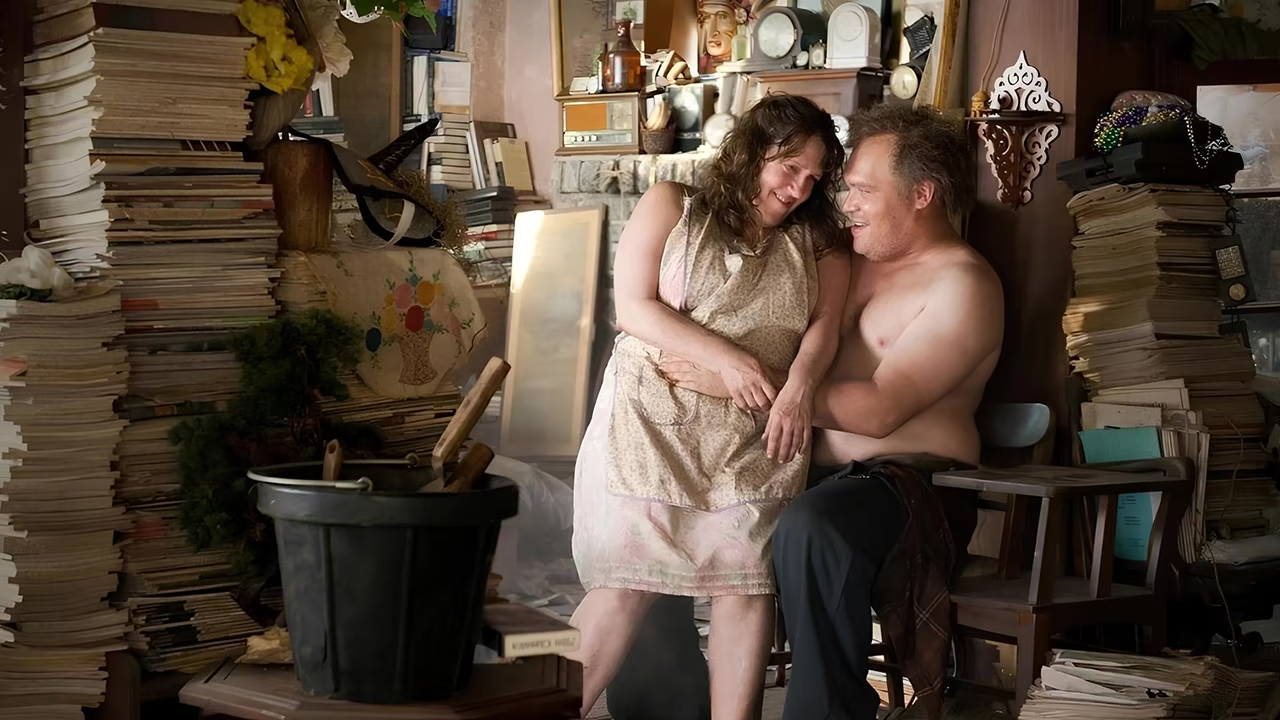
This brings the narrative back to 2012. The interrogations are a pretense; the new detectives suspect the pariah Rust might be the killer. They believe he’s orchestrating the crimes using insider knowledge. After the interviews, Marty and Rust meet for the first time in a decade. Rust reveals he never stopped investigating. He takes Marty to a storage locker containing his meticulously organized ten-year shadow investigation into the cult. Maps, photos of missing persons, and timelines cover the walls. Everything points to a vast conspiracy of abuse and murder involving the state’s most powerful families, especially the Tuttles. Rust’s most damning evidence is a videotape recovered from Reverend Tuttle’s safe. It shows the ritualistic rape and murder of Marie Fontenot. The horrific footage convinces Marty to join Rust in his quest for justice.
Working from Marty’s new private investigation firm, they dive into the cold case files. They track down a former maid of the Tuttle family, who identifies the scarred man as a grandson of the Tuttle patriarch, who was an illegitimate and disavowed member of the Childress line. They also discover that the original investigating officer in the Fontenot case was Steve Geraci (Michael Harney), now a parish sheriff. Marty and Rust confront Geraci, escalating from subtle pressure to force. They use the videotape to compel him to talk. Overwhelmed with fear, Geraci admits that his former boss, Sheriff Ted Childress, ordered him to drop the Fontenot case.
Meanwhile, Detectives Maynard Gilbough (Michael Potts) and Thomas Papania (Tory Kittles), still pursuing the case, search for the burned-down church to the south but become lost. They ask a man mowing the lawn at a cemetery for directions. The man guides them to their destination and reveals burn scars on his face. This man is Errol Childress (Glenn Fleshler), their target—the same groundskeeper Rust had briefly encountered at the school. Errol lives in a dilapidated house in the woods with Betty (Ann Dowd), his intellectually disabled half-sister, with whom he maintains an incestuous relationship.
Around the same time, they remember a detail from an old report. It describes a freshly painted green house near the scene of Dora Lange’s murder—matching the “green ears” mentioned in the earlier investigation. Tax records list the painter as “Childress and Son”. Following this lead, they arrive at a decaying house deep in the Louisiana backwoods. Marty approaches the house and is met by Betty, who refuses to let him in. Undeterred, Marty forces his way inside while Rust circles the property. From a distance, Rust spots Errol, a large man with severe facial scars. As soon as he notices Rust, he flees into the surrounding woods. Inside, Marty observes the squalid conditions and finds Betty laughing, warning that Errol is worse than anyone.
Marty rushes out to assist Rust but instead enters a nearby shed, where he discovers the bound, decaying corpse of Errol’s father, Billy Childress. Rust follows Errol into the maze-like structure, finding it filled with grotesque twig sculptures and the skeletal remains of past victims. At the center of this nightmarish place stands a monstrous effigy of the Yellow King. Rust freezes, overwhelmed by a vivid hallucination. He sees a swirling cosmic vortex that reflects his bleak worldview. Taking advantage of Rust’s hesitation, Errol stabs him in the abdomen. As Errol prepares to deliver the final blow, Marty arrives just in time and shoots him. Despite his injuries, Errol throws an axe that hits Marty in the chest. As the attacker looms over Marty, Rust summons the last of his strength, raises his pistol, and shoots Errol in the head, ending the fight.
In the aftermath, the police swarm the property and uncover the full extent of the Childress family’s evil. At the hospital, Marty learns that Rust, although gravely wounded, will survive. The final scene takes place outside the hospital at night. For the first time, Rust expresses a sense of hope. He describes a feeling he had while unconscious—a reunion with his deceased daughter and an overwhelming sense of love. Looking up at the vast, star-filled sky, he reflects on the battle between light and darkness. While the darkness may cover more ground, he believes the light is starting to win. Marty, moved by Rust’s words, places a hand on his friend’s shoulder and helps him back inside.
